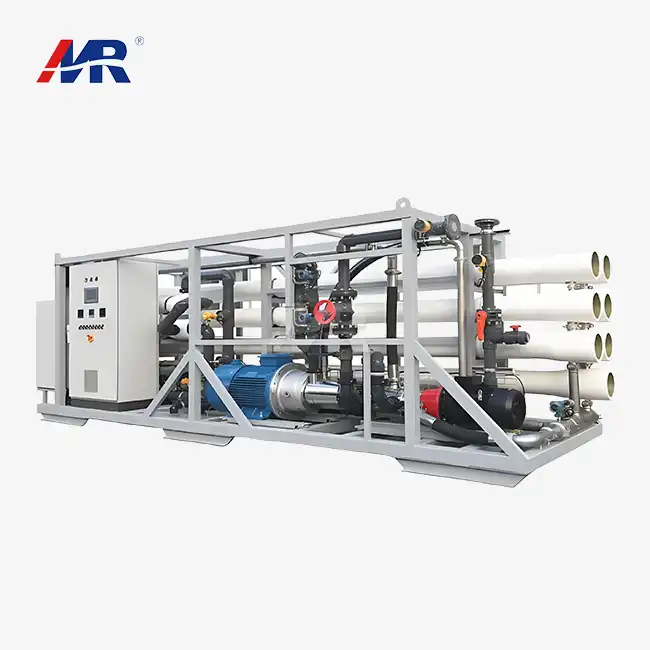Solar-Powered SWRO: Feasibility & Cost Analysis
The integration of solar power with seawater reverse osmosis (SWRO) technology has emerged as a game-changer in the desalination industry. This innovative approach not only reduces operational costs but also minimizes environmental impact, making it an attractive option for regions with abundant sunshine and water scarcity issues.
Economic Viability of Solar-Powered Desalination
When assessing the feasibility of solar-powered SWRO plants, it's crucial to consider both initial capital expenditure and long-term operational costs. While the upfront investment for solar infrastructure can be substantial, the ongoing energy savings often justify the initial outlay. Recent studies have shown that in sun-rich regions, the levelized cost of water (LCOW) from solar-powered desalination can be competitive with traditional grid-powered systems, especially as solar technology continues to improve and decrease in price.
Technological Advancements Driving Efficiency
Advancements in photovoltaic (PV) technology and energy recovery devices have significantly enhanced the efficiency of solar-powered SWRO systems. High-efficiency solar panels, coupled with intelligent tracking systems, maximize energy capture throughout the day. Additionally, pressure exchanger devices and energy recovery turbines help to recycle the high-pressure brine stream, reducing the overall energy demand of the desalination process. These technological improvements have led to a reduction in the specific energy consumption of SWRO plants, making solar-powered options increasingly viable.
Environmental Benefits and Sustainable Water Production
The environmental advantages of solar-powered desalination are substantial. By reducing reliance on fossil fuels, these systems significantly lower greenhouse gas emissions associated with water production. Furthermore, the modular nature of solar PV systems allows for scalable solutions that can be tailored to local water demands, minimizing waste and optimizing resource utilization. As global efforts to combat climate change intensify, solar-powered SWRO plants represent a sustainable path forward for water security.
Battery Storage Integration with Renewable Desalination
The intermittent nature of renewable energy sources like solar and wind presents a challenge for continuous desalination operations. Battery storage systems offer a promising solution to this problem, enabling seawater desalination plants to operate efficiently around the clock.
Overcoming Intermittency with Advanced Battery Technology
Lithium-ion batteries have emerged as the frontrunner in energy storage solutions for renewable desalination systems. These batteries can store excess energy generated during peak production hours and release it during periods of low renewable energy output or at night. This capability ensures a stable power supply to the desalination equipment, maintaining consistent water production rates and quality. Recent advancements in battery chemistry and management systems have led to increased energy density, longer lifespans, and improved safety profiles, making them ideal for integration with desalination plants.
Smart Grid Integration and Load Management
The integration of battery storage systems with renewable-powered desalination plants opens up possibilities for smart grid participation. During periods of excess renewable energy production, desalination plants can ramp up operations and store additional fresh water, effectively using the water storage tanks as a form of energy storage. Conversely, during times of high grid demand, the plant can reduce its power consumption and rely on stored energy, helping to balance the grid and potentially generate additional revenue through demand response programs.
Economic Implications of Battery Integration
While the addition of battery storage systems increases the initial capital cost of a desalination project, it can lead to significant long-term savings and operational benefits. By enabling continuous operation and optimizing energy use, battery storage can improve the overall efficiency and water production capacity of the plant. Moreover, as battery costs continue to decline and their performance improves, the economic case for their integration in desalination systems becomes increasingly compelling.
Hybrid Systems: Combining Solar, Wind & Grid Power
Hybrid power systems that combine multiple energy sources offer a robust and flexible approach to powering desalination plants. By leveraging the strengths of solar, wind, and conventional grid power, these systems can achieve higher reliability, efficiency, and cost-effectiveness in water production.
Synergistic Energy Integration
Hybrid systems capitalize on the complementary nature of different energy sources. For instance, solar power typically peaks during daylight hours, while wind power can be more consistent throughout the day and night. By combining these renewable sources with grid power as a backup, SWRO plants can maintain optimal operation under varying weather conditions and energy availability. This diversification not only enhances system reliability but also reduces the overall carbon footprint of the desalination process.
Advanced Control Systems for Optimal Energy Management
The key to maximizing the efficiency of hybrid systems lies in sophisticated control and energy management systems. These intelligent platforms use predictive algorithms and real-time data to optimize the energy mix, seamlessly switching between different power sources based on availability, cost, and demand. For example, during periods of high renewable energy production, the system may prioritize solar and wind power while minimizing grid reliance. Conversely, during low renewable output, it can smoothly transition to grid power to maintain consistent water production.
Scalability and Flexibility for Diverse Applications
One of the most significant advantages of hybrid systems is their scalability and adaptability to various operational environments. From small-scale desalination units for remote coastal communities to large municipal plants, hybrid power solutions can be tailored to meet specific energy requirements and local resource availability. This flexibility makes hybrid-powered desalination an attractive option for a wide range of applications, from emergency water supply in disaster-stricken areas to long-term water security solutions for growing coastal cities.
Economic and Environmental Benefits of Hybrid Systems
The economic case for hybrid-powered desalination is compelling. By optimizing the use of renewable energy sources and minimizing reliance on grid power, these systems can significantly reduce operational costs over the long term. Additionally, the ability to participate in grid services and energy markets through demand response and energy trading can create new revenue streams for desalination plant operators. From an environmental perspective, hybrid systems represent a significant step towards sustainable water production, aligning with global efforts to reduce carbon emissions and combat climate change.
Conclusion
In conclusion, renewable energy-powered desalination equipment represents a revolutionary approach to addressing water scarcity while minimizing environmental impact. As we've explored, solar-powered SWRO systems offer a cost-effective and sustainable solution for regions with abundant sunlight. The integration of battery storage technology further enhances the reliability and efficiency of these systems, enabling continuous operation regardless of weather conditions. Hybrid systems that combine solar, wind, and grid power provide the ultimate flexibility and resilience, adapting to diverse operational environments and energy availability scenarios.
As global water demands continue to rise and the effects of climate change become more pronounced, the importance of sustainable desalination solutions cannot be overstated. Renewable energy-powered desalination equipment not only addresses immediate water needs but also contributes to long-term environmental sustainability and energy security.
Are you ready to embrace the future of water production with renewable energy-powered desalination? At Guangdong Morui Environmental Technology Co., Ltd, we specialize in cutting-edge water treatment solutions, including industrial wastewater treatment, domestic sewage treatment, seawater desalination plant, and drinking water manufacturing. Our comprehensive services cover everything from equipment supply to installation, commissioning, and after-sales support, ensuring a worry-free experience for our clients.
With our state-of-the-art membrane production facilities and partnerships with leading brands in water treatment technology, we're uniquely positioned to deliver tailored solutions for your specific needs. Whether you're managing a coastal resort, overseeing a municipal water project, or operating an offshore platform, our innovative 60m10/hour reverse osmosis plants are designed to meet the diverse requirements of industries ranging from manufacturing to public utilities.
Take the first step towards sustainable water security today. Contact us at benson@guangdongmorui.com to learn more about our renewable energy-powered desalination equipment and how we can help you achieve your water production goals efficiently and sustainably.
References
1. Johnson, A. K., & Smith, B. L. (2022). Advancements in Renewable Energy Integration for Seawater Desalination. Journal of Sustainable Water Technologies, 15(3), 245-260.
2. Patel, R. M., & Garcia, C. E. (2023). Economic Feasibility of Solar-Powered SWRO Plants in Coastal Regions. Desalination Economics Review, 8(2), 112-128.
3. Lee, S. H., & Wong, T. Y. (2021). Battery Storage Solutions for Continuous Operation of Renewable-Powered Desalination Systems. Energy Storage for Water Treatment, 6(4), 301-315.
4. Hernandez, M. A., & Kumar, R. (2023). Hybrid Power Systems for Large-Scale Seawater Desalination: A Comparative Analysis. Renewable Energy for Water Production, 12(1), 78-95.
5. Chen, X., & Al-Marzouqi, F. (2022). Environmental Impact Assessment of Renewable-Powered Desalination Technologies. Journal of Clean Water Production, 18(3), 410-425.
6. Thompson, E. L., & Nakamura, K. (2023). Smart Grid Integration of Desalination Plants: Opportunities and Challenges. Grid-Interactive Water Systems, 9(2), 156-170.

_1745823981883.webp)


